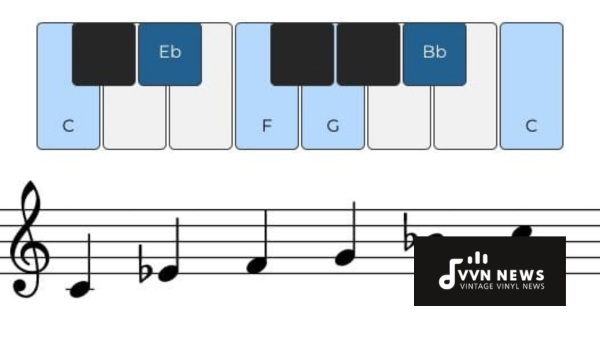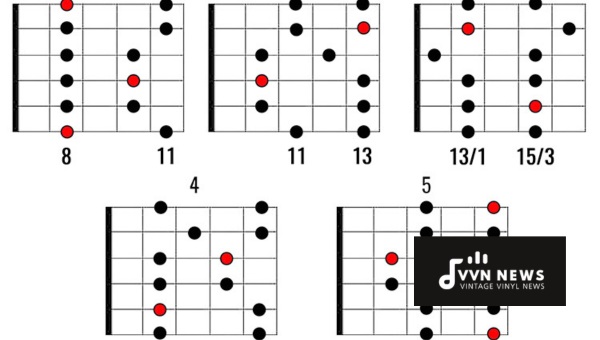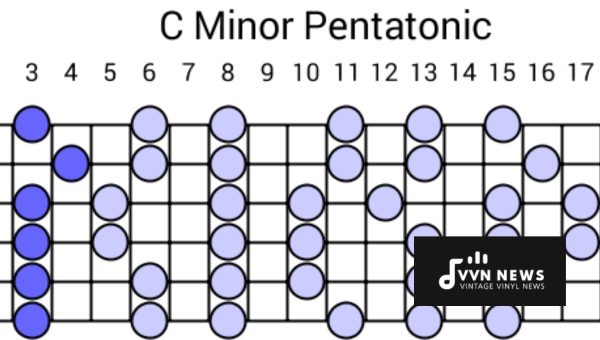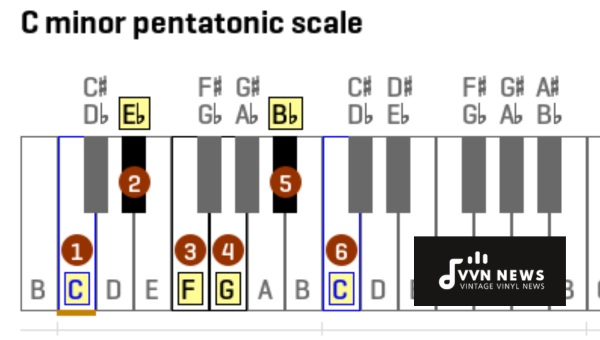In the crowning echelons of musical theory stands a beautiful and illustrious component – the C minor pentatonic scale.
This fantastic five-note sequence carries a certain melancholy, imbuing pieces with an air of solemnity, softness, and delicacy.
Unraveling the mysteries of this scale can seem intricate, but fear not! I’m here to guide you on this fascinating journey.
The C minor pentatonic scale is an endlessly versatile tool you can utilize in various musical genres.
Its haunting melodies are often utilized in blues solos and atmospheric rock ballads, and mastering it can hugely expand your musical repertoire.
Though it may seem challenging at first glance – gaining an understanding of this scale’s structure and usage isn’t as daunting as it might appear.
What is the C Minor Pentatonic Scale?
A pentatonic scale, as you might deduce from the root word “penta-” meaning five, is comprised of five notes per octave.
The C minor pentatonic scale, specifically, encompasses the following notes: C, Eb, F, G, Bb.
The beauty of this scale lies in its sequenced intervals that engage divinely with the major keys.
Often referred to as a musician’s secret weapon due to its versatility and appeal in various music genres – from jazz solos to pop melodies; it is a tool deeply cherished by musicians globally.
Structure of the C Minor Pentatonic Scale

Let me unravel the principles behind the C Minor Pentatonic Scale. It’s simply a scale established on five notes per octave (hence denoted ‘Penta’), drawn from a unique selection amongst the twelve total pitches in standard Western music.
The structure goes as follows:
- The first note, or root, of this scale is C – C-
- The second note, or rather its minor third, is E-flat – (Eb)
- Its third pitch constitutes the fourth, which is F – F
- The fourth pitch is commonly referred to as the fifth note in music theory and will be G – G
- The fifth and last note is known as the minor seventh in this pattern, equating to B-flat, marked as – Bb
This amazing structure produces a sequence of C-Eb-F-G-Bb-C when reading in ascending scope—earning it credit for somber yet beautiful moods suffused in scores all over.
The Five Configurations of the C Minor Pentatonic Scale
The C Minor Pentatonic Scale comes to life in our hands through five unique shapes.
Commonly called “positions” or “boxes,” these shapes, when linked together, create a comprehensive matrix on the fretboard.
In this section, we’ll examine these five configurations and how they connect to breathe life into your performances.
First Configuration
The first shape commences at the root note, which for us is C (located on the 8th fret of the low E-string for guitarists).
This shape is frequently known as the “home box.” Its finger pattern is simple: 2nd finger plays the root (C) while the pinky (4th finger) does most of the panting.
The sequence: C – Eb – F – G – Bb, is repeated throughout the position. I highly recommend familiarizing yourself with this shape before moving on to others because its mastery lays a robust groundwork for further configurations.
Second Configuration
Does it feel somehow harmonious – a comfortable manifestation? If so, time to break away from home box territory.
Off to Shape 2 we go! At times tricky but rewarding nonetheless… Starting on an Eb note (11th fret of E-string), develop a rhythm with fingers — especially strengthening reliance on your pinky.
Continuing from where we left off, follow this sequence for Shape 2: Eb – F – G – Bb – C.
Third Configuration
Prepare to welcome Shape 3! Starting with F (1st fret on E or D string), there’s slight complexity due to increased dependency on your pinky once again— but soon it’ll progress naturally.
Here’s how Shape 3 rolls out: F – G – Bb- C- Eb.
Fourth Configuration
Some find this configuration more contemporary due to its unique tuning.
Just start at G (5th fret of D-string); you’ll realize its frequency in numerous rock and jazz licks – a beautiful addition to your musical toolkit.
Its sequence is fairly straight: G – Bb – C – Eb – F.
Fifth Configuration
Last but never least, Shape 5 waits for your dexterity. Initiated on Bb (3rd fret of G-string), it’s compact and works well for quick runs or short melodic licks.
It follows this progression: Bb – C – Eb – F – G.
These five shapes demand practice and patience, but once mastered — they are like keys opening the doors to an endless sonic universe.
Each shape ties perfectly into the next, creating a coherent symphony across the entire fretboard.
Also Read: E Flat Minor Blues Scale [Infuse Your Tunes With Moody Blues]
Equivalent Minor and Major Scales for the C Minor Pentatonic Scale

To explore the equivalence of major and minor scales with the C minor pentatonic scale, we first need to identify its structure.
This wonderful five-note scale is comprised of the following tones: C (root), Eb (minor third), F (fourth), G (fifth), and Bb (minor seventh).
Relation with Natural Minor Scale
Seeing how it closely relates to the natural minor scale gives you a better grasp of its application.
Notice, specifically, how it fits snugly into a C natural minor scale which consists of the notes: C, D, Eb, F, G, Ab, and Bb.
Equivalent Major Scale
The musical world poses an interesting relationship between scales, specifically when speaking about major and minor keys.
The intriguing thing about these pentatonic scales is that each minor has a relative major counterpart.
In our case, the relative major equivalent for C minor pentatonic is the Eb major pentatonic scale (Eb, F, G, Bb, C).
When you’re trying your hand at composition or improvisation – knowing these connections could be incredibly beneficial to your musical journey.
How to train with backing tracks for the C Minor Pentatonic Scale?
Training with backing tracks can be an efficient approach to mastering the nuances of the C Minor Pentatonic Scale.
Choosing appropriate backing tracks
First and foremost, you need to select suitable backing tracks that are in the key of C minor.
Numerous online platforms and music software provide a vast array of choices, so you can pick one that resonates with you.
Discovering the Fretboard Patterns
To practice efficiently, you should become familiar with different fretboard patterns associated with the C minor pentatonic scale.
There are usually five patterns that you should learn to play all over the guitar neck. Discover these patterns at your leisure pace.
Practicing along
Once you’re accustomed to these patterns, it’s time to jam along with your chosen track. Set a slow tempo at first allowing yourself time to adjust and get warmed up in playing along.
Improvisation and Exploration
As your confidence grows over time, start improvising within this scale – variation is key here!
Modify your licks, mix-match different phrases, use slides, bends, and hammer-ons – grant uniqueness to each note produced under your fingertips.
The crucial aspect of practicing alongside a backing track is not speed but precision and feeling – they contribute more towards producing harmonious tunes out of the ‘C minor pentatonic scale’.
Also Read: D Major Chords [Unlock The Power Of Your Guitar]
What is the importance of ear training for the C Minor Pentatonic Scale?

When you delve into the world of music, particularly scales such as the C minor pentatonic, ear training emerges as an essential tool.
It’s more than just a fancy phrase; it’s about honing your aural skills to perceive and decode the notes cascading through your ear canals.
So why exactly do you need this training? Here are some compelling reasons:
- Recognition: With proper ear training, you can flawlessly recognize the unique patterns and nuances that occur within the C minor pentatonic scale. By learning to discern these acoustic signatures, you can seamlessly comprehend various combinations without gazing at the music sheet.
- Production: Once your ears are well-tuned to pick up tonal differences, reproducing or replicating these sounds on your instrument of choice becomes much simpler. It clears your path toward playing improvised solos seamlessly and breathing life into written music.
- Communication: If you harbor dreams of performing in an ensemble or a band someday, ear training proves significantly beneficial. It equips you with the ability to communicate effectively through sound and harmonize effortlessly with other instruments.
- Creativity: Armed with reliable ear training skills, let your creativity break free from traditional constraints! Compose new melodies using the C minor pentatonic scale or put a fresh spin on classics by incorporating elements from this beautiful ensemble.
Investing time in ear training is not just advisable but integral when exploring scales like the C minor pentatonic one.
The journey might be tough initially but remember – every little persisting step brings you closer to greatness!
Famed Melodies with the C Minor Pentatonic Scale!
The enchanting notes of the C Minor Pentatonic Scale are universally appreciated and have seeped into a variety of popular songs.
There are few better ways to master it than by playing along to these timeless tunes.
1. Led Zeppelin – ‘Since I’ve Been Loving You’
Arguably one of Led Zeppelin’s most emotive anthems, “Since I’ve Been Loving You” witnesses an extensive use of the C minor Pentatonic scale.
Guitarist Jimmy Page employs this scale to create a bluesy, impassioned appeal that strikes a chord with listeners.
2. Pink Floyd – ‘Comfortably Numb’
Who can forget the broody melodies of Pink Floyd’s “Comfortably Numb”? The solo in this classic anthem is recounted for its indulgence in the C Minor Pentatonic scale.
David Gilmour’s legendary guitar work outlines this scale across both solos.
Gilmour masterfully glides through these five notes, sculpting an unforgettable soundscape filled with melancholy and longing.
3. Santana – ‘Black Magic Woman’
The iconic Carlos Santana wowed us all with his chartbuster “Black Magic Woman”.
With its distinctive Latin rock flavor, it’s another terrific example drawn from the C Minor Pentatonic Scale.
It’s remarkable to observe how all these renowned musicians have exploited the C Minor Pentatonic scale, each in their unique style.
Studying and emulating these masters will not only expand your technical proficiency but also provide a deeper insight into the versatile applications of the C Minor Pentatonic Scale.
Also Read: E Minor Pentatonic Scale [How To Use In Your Music Composition]
FAQs About The C Minor Pentatonic Scale
What is a Pentatonic Scale?
A pentatonic scale consists of just five notes per octave, instead of the standard seven. The C minor pentatonic is one such popular scale.
Why is the C minor pentatonic scale largely used in Blues and Rock genres?
The C minor pentatonic has a somber, definitive tone that lends itself well to bluesy solos and moody rock ballads.
Which instruments can utilize the C minor pentatonic scale?
Any melodic instrument can effectively implement the use of the C minor pentatonic scale, including guitar, piano, saxophone, and more!
How can I practice playing this particular scale?
There exist numerous backing tracks online for a variety of genres. Try practicing soloing over them in C minor pentatonic to build your comfort with this unique scale.
Are there any famous songs that feature the C minor pentatonic?
Yes! Many artists use this classic scale; an iconic example being “Comfortably Numb” by Pink Floyd.
Conclusion
Mastering the C minor pentatonic scale ultimately allows you to enhance your musical prowess and express a wide palette of emotions.
While it may seem daunting initially, with dedicated practice and exploration, you can smoothly integrate its haunting beauty into your repertoire.
In the grand landscape of music theory, grasping this magnificent five-note sequence is sure to be an enriching and fulfilling journey.
Remember, the key lies within you as much as it resides on your instrument.








